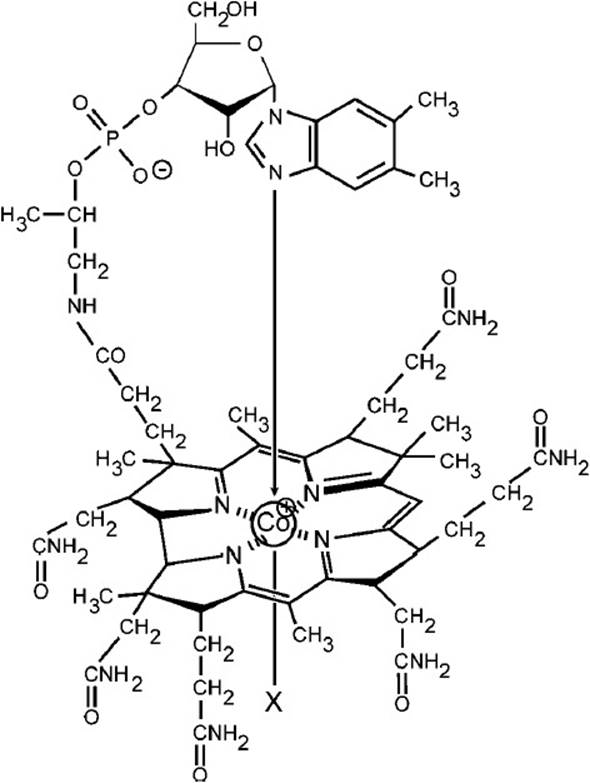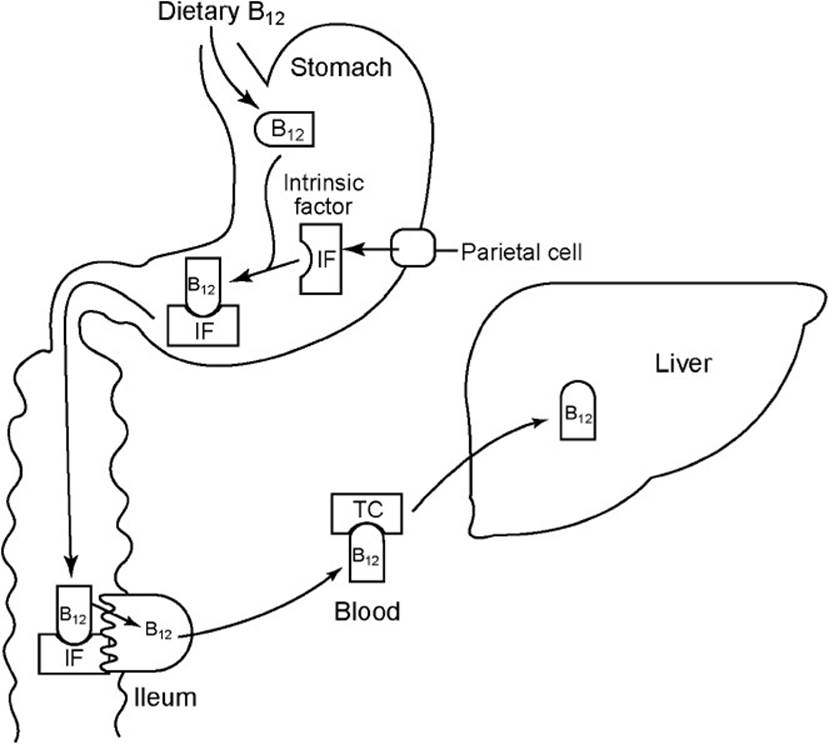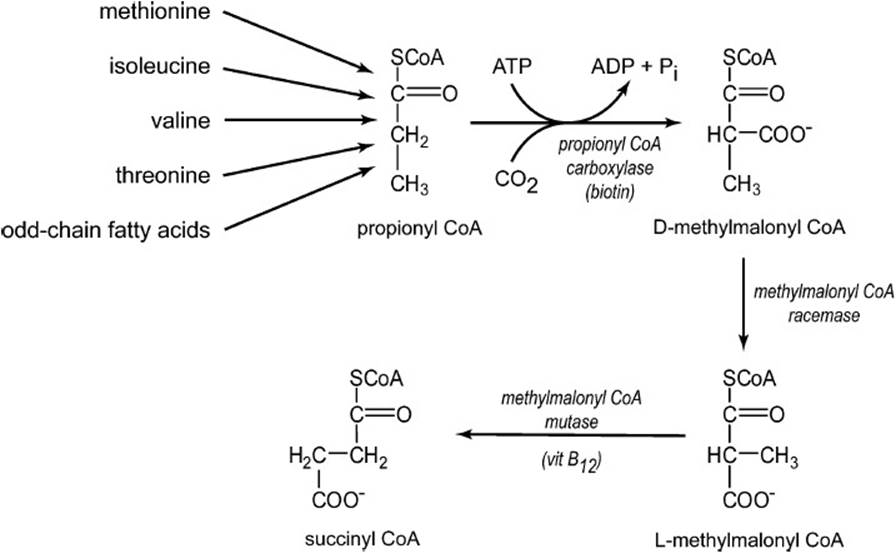Case Files Biochemistry, 3rd Edition (2015)
SECTION II. Clinical Cases
CASE 42
A 38-year-old vegetarian (vegan) Caucasian woman presents to her primary care doctor with fatigue and tingling/numbness in her extremities (bilateral). The symptoms have been gradually getting worse over the last year. Upon further questioning she reports frequent episodes of diarrhea and weight loss. On examination, she is pale and tachycardic. Her tongue is beefy red and a neurologic examination reveals numbness in all extremities with decreased vibration senses. A complete blood count demonstrates megaloblastic anemia.
![]() What is the most likely diagnosis?
What is the most likely diagnosis?
![]() What is the most likely underlying problem for this patient?
What is the most likely underlying problem for this patient?
![]() What are the 2 most common causes of megaloblastic anemia and how would this patient’s history and examination differentiate these 2 causes?
What are the 2 most common causes of megaloblastic anemia and how would this patient’s history and examination differentiate these 2 causes?
ANSWERS TO CASE 42:
Cobalamin Deficiency (Vitamin B12)
Summary: A 38-year-old vegetarian woman with gradually worsening fatigue, neurologic and gastrointestinal (GI) symptoms, and megaloblastic anemia.
• Diagnosis: Cobalamin (vitamin B12) deficiency.
• Underlying problem: Lack of cobalamin intake with complete vegetarian diet (vegan).
• Causes of megaloblastic anemia: Folate and cobalamin deficiency. Patients with folate deficiency have similar hematologic and GI findings but do not have the neurologic symptoms as with cobalamin deficiency.
CLINICAL CORRELATION
The 2 most common etiologies of megaloblastic anemia are deficiencies in folate or cobalamin. Cobalamin deficiency can occur from a lack of intake (such as with complete vegetarians), absence of intrinsic factor (either inherited or from removal/damage to gastric mucosa), intestinal organisms, or ileal abnormalities (tropical sprue). Patients present with anemic symptoms, including fatigue, weakness, palpitations, vertigo, and tachycardia. GI symptoms include sore, beefy-red tongue, weight loss, and diarrhea. Both folate and cobalamin deficiencies have similar anemic and GI symptoms. However, cobalamin deficiency also can present with numerous neurologic manifestations including: numbness, paresthesia, weakness, ataxia, abnormal reflexes, diminished vibratory sensation, and disturbances in mentation (from irritability to psychosis). Treatment consists of identifying/treating the underlying cause of deficiency and replacement of cobalamin or folate.
OBJECTIVES
1. Describe the role of cobalamin in red blood cell formation.
2. Explain why cobalamin deficiency leads to megaloblastic anemia.
3. Develop a comprehension of the role of cobalamin in metabolism.
DEFINITIONS
COBALAMIN (VITAMIN B12) DEFICIENCY: Inadequate uptake of cobalamin from the diet; often due to lack of intrinsic factor an intestinal transport protein or less often due to unaugmented vegetarian diet that strictly avoids meat or meat products, the source of dietary cobalamin.
MEGALOBLASTIC ANEMIA: A disturbance in erythroid cell synthesis due to an impaired DNA synthesis. This results in cells with small nuclei and normal cytoplasm, and a high RNA to DNA ratio. Impaired DNA synthesis is due to decreased thymidylate synthetase conversion (C1 transfer) of deoxyuridine monophosphate (dUMP) to deoxythymidine monophosphate (dTMP) as a result of insufficient cobalamin or folate pool impairment.
ONE-CARBON POOL: Folate derivatives that carry a single carbon in various oxidation states (formyl, methenyl, methylene, and methyl) for transfer to acceptor molecules; that is, transfer to deoxyuridine monophosphate to form deoxythymidine monophosphate; transfer to homocysteine to form methionine.
DISCUSSION
The structure of cobalamin (vitamin B12) is shown in Figure 42-1. Cobalamin is somewhat analogous to heme in its structure having as its base a tetrapyrrole ring. Instead of iron as a metal cofactor for heme, cobalamin has cobalt in a coordination state of 6 with a benzimidazole group nitrogen coordinated to one axial position, the 4 equatorial positions coordinated by the nitrogens of the 4 pyrrole groups and the sixth position occupied by either a deoxyadenosine group, a methyl group or a CN− group in the commercially available form in vitamin tablets. Dietary cobalamin is absorbed in the Co3+ oxidation state and must be reduced by intracellular reductases to the Co+ form for use.

Figure 42-1. The structure of cobalamin, vitamin B12. X = deoxyadenosine in deoxyadenyosylcobalamin; X = CH3 in methylcobalamin; X = CN− in cyanocobalamin, the commercial form found in vitamin tablets.
Dietary cobalamin is absorbed from animal food sources by a multistage process shown in Figure 42-2. Cobalamin absorption requires the presence of a protein (the intrinsic factor) secreted from the parietal cells of the stomach to bind cobalamin and aid in its absorption in the ileum. The protein is released into the ileum while the cobalamin is transported to the blood stream where it binds specialized serum proteins, the transcobalamins, which transport it to other tissues such as liver where cobalamin can be stored (usually several milligrams are present in liver). In the absence of the intrinsic factor inadequate amounts of cobalamin are absorbed (the dietary requirement is approximately 200 ng/day) resulting in megaloblastic anemia. When the root cause of the resultant megaloblastic anemia is absence of or inadequate amounts of intrinsic factor the condition is called pernicious anemia. Other conditions or choices may also eventuate in cobalamin deficiency–induced megaloblastic anemia. This condition is also observed in vegetarians who strictly avoid meat and meat products.

Figure 42-2. Absorption, transport, and storage of vitamin B12. IF = intrinsic factor, a glycoprotein secreted by gastric parietal cells; TC = transcobalamins, blood proteins that carry cobalamin to the liver. (Reproduced, with permission, from D.B. Marks, et al. Basic Medical Biochemistry: A Clinical Approach. Philadelphia: Lippincott Williams & Wilkins; 1996:619.)
The cause of megaloblastic anemia seen in strict nonsupplemented vegetarians is attributed to the effects of cobalamin deficiency on DNA synthesis, specifically the thymidylate synthetase reaction, which converts dUMP to dTMP. Inadequate dTMP restricts DNA but not RNA synthesis, leading to the appearance of large erythroid cells with small nuclei containing a high ratio of RNA to DNA. These cells are removed from the circulation, thus stimulating erythrogenesis and giving rise to anemia with an elevated presence of megaloblasts.
This process focuses on the role of cobalamin in folate metabolism. As shown in Figure 42-3, cobalamin is required for the conversion of homocysteine into methionine. Cobalamin must first undergo methyl transfer to form methyl cobalamin. It receives the methyl group from N5-methyltetrahydrofolate thus regenerating tetrahydrofolate to participate in other one-carbon transfers in purine metabolism or pyrimidine remodeling. If there is a cobalamin deficiency, then the methionine synthase reaction cannot occur, N5-methyltetrahydrofolate accumulates and the other C-1 donor forms of tetrahydrofolate cannot be formed. If N5, N10-methylenetetrahydrofolate, which is required for the methylation of dUMP to dTMP, cannot be formed, then the thymidylate synthase reaction will be slowed and dTMP levels will drop. An added complication is that the thymidylate synthase reaction produces dihydrofolate unlike all the other C-1 pool reactions, which produce tetrahydrofolate. The dihydro-form must be reduced to the tetrahydro-form by dihydrofolate reductase, which can be inhibited by many drugs. Thus, in the absence of cobalamin, methionine synthesis from homocysteine ceases, allowing the “trapping” of the folate pool as N5-methyltetrahydrofolate, diminishing levels of N5, N10-methylenetetrahydrofolate, and impairing dTMP formation and, thus, DNA synthesis. Cells requiring regeneration due to turnover feel the brunt of this situation early and thus megaloblastic anemia is a result.

Figure 42-3. The role of cobalamin as a cofactor in the methylation of homocysteine to methionine.
Role of Cobalamin in Metabolism
Cobalamin plays a vital role in the catabolism of odd-chain fatty acids, threonine, methionine, and the branched-chain amino acids (leucine, isoleucine, and valine), as shown in Figure 42-4. The degradation of each of the compounds named above produces the same metabolite, propionyl-CoA. This activated 3-carbon fatty acid enters the energy generating metabolic pathway at the level of the citric acid cycle as succinyl-CoA. The process requires 3 specialized enzymes. Propionyl-CoA carboxylase adds another carbon to propionyl-CoA to form D-methylmalonyl-CoA in a reaction that requires ATP and the CO2-binding cofactor biotin. A racemase converts the D isomer of methylmalonyl-CoA to the L isomer. The last step is catalyzed by methylmalonyl-CoA mutase, a deoxyadenosylcobalamin-requiring enzyme that moves the acyl-CoA group from the methylene carbon to the methyl carbon to form succinyl-CoA. In cases of cobalamin deficiency this reaction is compromised and leads to an accumulation of methylmalonyl-CoA in serum, which has been suggested as a possible source of neurologic defects seen in cobalamin deficiency by decreasing lipid synthesis. Alternatively, impaired biosynthesis of phosphatidyl choline due to decreased levels of methionine and S-adenosylmethionine may play a role for the neurologic symptoms of cobalamin deficiency by compromising the repair of demyelination.

Figure 42-4. The role of vitamin B12 in the conversion of propionyl-CoA to succinyl-CoA.
COMPREHENSION QUESTIONS
42.1 A patient with a tentative diagnosis of cobalamin deficiency is awaiting a comprehensive blood analysis. Which of the following perturbations would NOT fit with the putative diagnosis?
A. Elevated levels of methylmalonic acid
B. Elevated levels of propionic acid
C. Elevated levels of para-hydroxyphenylpyruvate
D. Decreased levels of erythrocytes
E. Elevated levels of megaloblasts
42.2 In evaluating the case presented above your resident asks questions of the role of cobalamin in metabolism. Which of the following statements is true?
A. Cyanocobalamin is the principal form of cobalamin physiologically used.
B. Cobalamin is equally active with an iron cofactor.
C. Enterocytes produce an intrinsic factor required for uptake of cobalamin in the gut.
D. Cobalamin is transported in the blood to tissues by proteins named transcobalamins.
E. Cobalamin is active in its 3+ oxidation state.
42.3 Megaloblastic anemia has 2 most likely causes, deficiency of folate and deficiency of cobalamin. Often treatment of patients with cobalamin deficiency improves in terms of their hematologic features with treatment with folate but not in their neurologic symptoms. What is the most likely explanation for this explanation?
A. Cobalamin deficiencies are not serious.
B. Excess folate blunts the trapping of folate as N5-methyltetrahydrofolate.
C. Folate in high concentrations can serve as cofactor for the conversion of homocysteine to methionine.
D. Excess folate directly inhibits the destruction of red blood cells.
E. Excess folate stimulates erythropoietic tissues to synthesize cobalamin in situ.
ANSWERS
42.1 C. Para-hydroxyphenylpyruvate is the α-keto acid cognate of tyrosine and is not affected by cobalamin levels. All others result from cobalamin deficiency.
42.2 D. Cobalamin is transported in the blood by transcobalamins. Cyanocobalamin, the pharmacologic preparation of cobalamin available in vitamin pills, is a active as is. Cobalamin is not active with an iron cofactor. The intrinsic factor is produced by parietal cells in the stomach. Cobalamin must be reduced to the Co+ state for activity.
42.3 B. Excess folate, by overwhelming the folate pool trapped as N5-methyltetrahydrofolate, can allow for formation of N5, N10-methylenetetrahydrofolate, which is required for the thymidylate synthase reaction for DNA synthesis and red blood cell formation. Folate is not recognized as a methyl donor by methionine synthase. Folate does not inhibit destruction of erythrocytes. Cobalamin is an important critical vitamin not synthesized by humans.
BIOCHEMISTRY PEARLS
![]() Vitamin B12 (cobalamin) plays a critical role in DNA synthesis and neurologic function.
Vitamin B12 (cobalamin) plays a critical role in DNA synthesis and neurologic function.
![]() Cobalamin deficiency can lead to a wide spectrum of hematologic, neuropsychiatric, and cardiovascular disorders that can often be reversed by early diagnosis and prompt treatment.
Cobalamin deficiency can lead to a wide spectrum of hematologic, neuropsychiatric, and cardiovascular disorders that can often be reversed by early diagnosis and prompt treatment.
![]() Cobalamin absorption from the GI tract requires the presence of a protein (the intrinsic factor) secreted from the parietal cells of the stomach to bind cobalamin and aid in its absorption in the ileum.
Cobalamin absorption from the GI tract requires the presence of a protein (the intrinsic factor) secreted from the parietal cells of the stomach to bind cobalamin and aid in its absorption in the ileum.
REFERENCES
Devlin TM, ed. Textbook of Biochemistry with Clinical Correlations. 7th ed. New York: Wiley-Liss; 2010.
Longo D, Fauci AS, Kaspar D, et al, eds. Harrison’s Principles of Internal Medicine. 18th ed. New York: McGraw-Hill; 2011.
Scriver CR, Beaudet AL, Sly WS, et al. The Metabolic and Molecular Basis of Inherited Disease. 8th ed, New York: McGraw Hill; 2001:2165-2193.